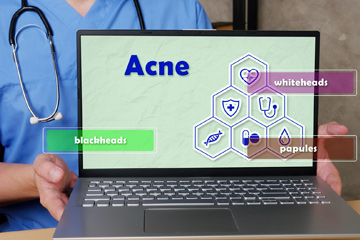Everybody likes a smooth and supple face that has a glow from within, but everyone is not blessed with a soft face. Acne is a nightmare, especially for teenagers and this concern could continue until adulthood. Pimples, acne and redness are commonly found skin conditions on both men and women. Around 80 percent of the people who have acne are between the ages 11 to 30.
Acne is caused when bacteria, oil and dead skin fill up and inflame pores, the tiny openings in your skin through which oil and sweat rise to the surface. Another cause for acne is hormone changes. Stress, the environment, exposure to harsh sun, menstrual cycles, oil-based products and birth control pills are also other causes for acne.
Types of Acne
- Pustules: These are pus-filled lesions that are red at the base and white or yellow at the top.
- Papules: These acnes are in pink to red bumps that hurt when you touch them.
- Nodules: These are solid lesions which are larger than papules and pustules. They extend deeper into the skin are painful too.
- Cysts: Cysts lie deep within the skin which are painful, full of pus and likely to cause scars.
The skin is the largest organ in the human body and it protects you from harmful UV rays and bacteria. The areas that have sebaceous glands are prone to acne like the face, back and chest. Acne scars are caused by the inflammation of acne blemishes. The acne pore swells and a breakdown occurs in the wall of the pore. Some acne blemishes are small and the scars created are shallow and heal quickly. Sometimes the contents of blemishes spill into the surrounding tissue and cause deeper scars. Some acne scars fade with time but some do not. So here are some tips to remove acne scars:
- Home Remedies:
- Retinoids: Topical retinoids prevent inflammation, reduces acne lesions, and quicken regeneration of cells. It also helps to lighten hyperpigmented acne scars, including those in people with darker skin tones. Remember, retinoids can make your skin sensitive to sun, so take necessary measures like sunscreen lotions etc.
- Salicylic Acid: It is a naturally occurring compound that is often an ingredient in acne skin care products. It helps to clears dirt, skin cells, and other debris that leads to acne from the pores of the skin. It helps to minimize swelling and redness that reduces scarring. So use products that contains salicylic acid in your skin care routine.
- Lactic Acid: It acts as a gentle peel to pull away dead skin cells and minimizes the appearance of scars and smoothen the overall texture of the skin. It lightens scar and hyper pigmentation. It is also present in diluted apple cider vinegar.
- Alpha Hydroxyl Acid: Alpha hydroxy acids (AHAs) helps to get rid of dead skin cells and prevent clogged pores. Doctors may recommend AHAs for treating acne and reducing the appearance of acne scars. It mildly scraps out the outer layer to reveal the fresh skin underneath.
- Natural Remedies: These include honey, coconut oil, lemon juice, aloevera gel, shea butter etc.
- Medical Treatments:
- Chemical Peel: A chemical solution is applied by the doctor to remove the top layer of skin and minimize the appearance of deeper scars. This process can be repeated to maintain the results. There can be some side effects like change in skin colour.
- Laser Resurfacing: This is a popular treatment that is usually performed on scars that were once treated with dermabrasion. This technique has an increased risk of side effects for people with darker skin or a history of keloids.
- Soft Tissue Fillers: Injecting collagen or fat or any other similar substance under the skin to make it plumper and make the scar less noticeable. This is a temporary treatment, so you will have to repeat the treatment when required.
- Dermabrasion: This procedure is ideal for severe scarring. The doctor removes the top layer with a rotating brush. Surface scars may be completely removed, and deeper acne scars may appear less noticeable.
- Surgery: This is a minor surgery called punch excision. In this procedure the doctor cuts out individual acne scars and repairs the wound with stitches or a skin graft.
- Skin Needling: Your doctor rolls a needle-studded device over the skin to stimulate collagen formation in the underlying tissue. It’s a safe and simple process for acne scarring with minimal risk of discoloring the skin. Results are subtle, and you may need repeat treatments.
- OnabotulinumtoxinA (Botox): Sometimes the skin around acne scars puckers. Injecting Botox helps to relax the surrounding skin that improves the appearance of an acne scar. The results are temporary, so repeat treatments may be needed.
All the above-mentioned tips help to remove acne scars and for medical treatments, you can reach out to a reliable plastic surgeon who can provide the right treatment for your acne scar.
